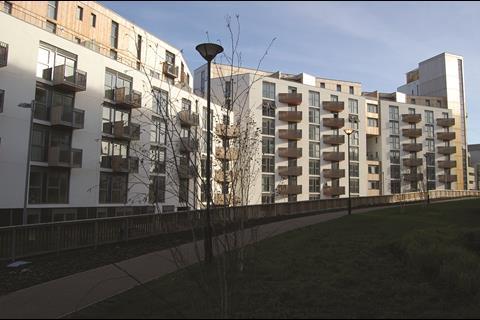With the energy performance of new homes proving far worse in practice than in theory, the government has been spurred into action - but its proposed quality assurance process for Part L compliance has not met with universal approval
On 31 January the government published proposals for radical changes to Part L, the �ڶ����� Regulation relating to the conservation of fuel and power. One of the most controversial is the introduction of a quality assurance process to tackle the apparent discrepancy between the theoretical energy performance of new homes and their actual, as-built performance.
The proposal is that this could be delivered through the publication of a Publicly Available Specification (PAS), which would set out good practice in the design and construction of homes. Alongside the specification, the communities department is proposing to introduce an accreditation scheme for housebuilders, which will provide them with the means to demonstrate that they have the capability to follow the PAS.
The scheme is not compulsory; housebuilders who decide they don’t want to follow the standard will, as an alternative, have to improve a home’s design energy performance by 3% - the idea being this will compensate for any shortfall in as-built energy performance.
These changes are proving to be highly contentious. Some in the industry have branded them inappropriate, and even unfair, amid claims that there is insufficient evidence to justify such a resource-intensive and expensive amendment. Others have welcomed the scheme as a means of providing the opportunity to address a long-established problem.
The performance gap
The inclusion of the proposal to tackle any discrepancy between the as-designed fabric heat loss and the fabric’s actual heat loss follows the recent publication of a series of studies which suggest that even the best-performing dwellings are typically losing 10-15% more heat than the target.
Jez Wingfield, now of Wilmott Dixon, was until recently a senior researcher specialising in building performance at Leeds Metropolitan University and has been responsible for some of these tests. He says that every time he has done a comparison there has been a performance gap of 10% or higher.
“At Wilmott Dixon, we think there is sufficient evidence [of a performance shortfall] gathered by myself and others in academia,” he says.
Wingfield argues that the performance shortfall is down to buildability and “being able to build what has been designed”. He cites a number of factors including: some materials having a different performance under site conditions compared to the laboratory; inherent performance differences in materials; and variations in tolerances on site.
According to Wingfield, thermal performance should be designed with a margin for error, in the same way that a structural engineer will include a factor of safety. “We assume that what we design is replicated exactly on site - it’s unrealistic,” he says. By setting out to just meet thermal performance criteria, housebuilders are setting themselves up to fail. “No-one ever over-designs thermal performance, because it costs money,” he says.
If the proposals are adopted, housebuilders will need to test a sample of homes to prove these are compliant and aligned with their design processes. “It’s no good just measuring your heat loss, you need to understand how the building was designed and constructed so that you can identify where any problems originated,” says Wingfield.
He says Wilmott Dixon is already starting to put in place a process for testing, regardless of the outcome of the consultation. “We need to understand how our buildings work so that we can feed that information back into our process to understand what we can do better.”
Too onerous?
The Good Homes Alliance (GHA), a group of developers that aim to improve the performance of housing, back the sentiment behind the initiative but claim the current proposal is too onerous. In its response to the consultation the organisation supports the government’s intention to address the performance gap but says “the current proposals would not achieve this”.
The proposal to adopt the PAS to cover design, procurement, supply, construction, commissioning and handover is an “all or nothing” solution on the basis that if any one element of the scope is not complied with a 3% confidence factor is applied.
The GHA is recommending the government consider only applying the standard to areas where evidence already suggests there are consistent shortcomings to ensure it is “not considered overwhelming”.
Other housebuilders remain unconvinced that a problem exists in the first place. The Home Builders Federation, the organisation representing private housebuilders, is strongly opposed to the proposal on the basis that there is insufficient evidence for it to be introduced.
The federation is calling for more detailed research to be undertaken to enable a more focused proposal. “There is, at present, an insufficient evidence base to enable us to understand the scale and reasons for any performance gap,” the organisation states in its covering letter sent to the communities department with the HBF’s response to the consultation.
“We are not in favour of the PAS as proposed. The idea of a quality assurance scheme across the board without knowing what the issues are appears to us to be misconceived,” says John Slaughter, the HBF’s director of external affairs.
You have to have a system designed for the users and consumers and not for firms looking to make money
In addition to further research, the HBF is also proposing that new performance tests be developed that can be applied during construction so that if there is a performance problem it would be less expensive to rectify.
“If we are going to tackle this, we actually need to develop some new tests both in production and post-production with government through the Technology Strategy Board,” explains Slaughter. Without a detailed knowledge of the problem, the HBF say it will be too difficult to produce the PAS.
According to Wilmott Dixon’s Wingfield, the PAS will need to put in place the processes to explain how to accredit a thermal bridging calculation, how to inspect details on site, how to be sure material information from the supply chain is correct, along with the levels of measurement that will be needed and the percentage of homes that will have to be tested. “I suspect that tests will not be very onerous initially,” he predicts.
The proposal is for housebuilders to be accredited as capable of meeting the requirements of the PAS. National body the UK Accreditation Service says accreditation will be through certification bodies.
However, the Construction Products Association (CPA) has concerns that certification bodies are likely to be hijacked by consultants with an eye to making an easy buck out of the accreditation process.
“You have to have a system designed for the users and consumers and not for the benefit of firms looking to make money out of compliance,” saysJohn Tebbit, industry affairs director at the CPA. “The concern from a number of our members is that it will become a bureaucratic tick-box,” he adds.
The 3% factor
For housebuilders who decide not to follow the quality assurance route, the government is proposing to add 3% to the design energy target. However, Wingfield says the 3% is a long way short of what is needed. “Of the evidence I’ve seen, 3% does not go anywhere near to taking account of underperformance,” he says.
According to him, the additional 3% measures have been estimated to cost “about £150 for every new home”.
Wingfield says housebuilders should think about taking part in the proposal as a learning exercise, with the 3% compliance factor as a cost incentive. It is the first step in a seven-year journey.
“The ultimate government target is for 95% of all new housing to meet or exceed their design energy target when measured,” he points out.
The HBF describes the 3% proposal as “in principle unfair” on the basis that forcing housebuilders to choose between adopting the PAS or building to a higher performance standard assumes any issues involved in a performance gap are the responsibility of the housebuilder.
The organisation cites shortcomings in the Part L compliance calculation tool SAP, the lack of robust in-situ performance data from manufacturers and problems with assessment as all being issues responsible for the shortfall that are outside housebuilders’ control.
There are also concerns at the HBF that the 3% penalty will be disproportionately difficult to implement because designs are already approaching the margin of what is achievable for a building’s fabric on a mass-market basis. “If the alternative to meeting the government’s requirements is over-designing it pushes you into other things like putting renewables on the roof, which will have both cost and design implications,” says the HBF’s Slaughter.
The regulation is expected to come into effect in January 2013. However, amid so much controversy, the question remains whether the government will resolve all of the issues in time for publication. Willmott Dixon’s Wingfield says: “It’s not going to be easy, but if we don’t do it we will carry on building buildings that don’t work.”





























No comments yet